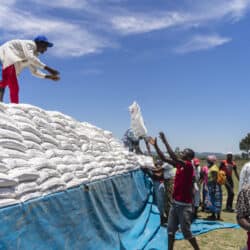There are few Canadian policy areas with a wider gulf between perception and reality than foreign aid.
Canadians routinely and dramatically overestimate the generosity of a government that is perceived as being deeply altruistic, when, in fact, it is increasingly miserly. A Nanos poll done for the Canadian Partnership for Women and Children’s Health (CanWaCH) in June 2019 found Canadians believe their government spends 17 cents of every dollar on foreign aid, eight times the actual rate. The government itself concedes it must do a better job of explaining to the Canadian public why it gives and where it gives.
A half-century after former Prime Minister Lester Pearson called on the world’s industrialized nations to spend 0.7% of Gross Domestic Income (GDI) on foreign aid, this country sits at a near 50-year low in spending as a percentage of GDI, 0.28%.
When it came to power in 2015, the Justin Trudeau government promised it would halt the decline in foreign aid spending that occurred under the Stephen Harper Conservatives as part of its boast that “Canada is back,” on the global stage. Foreign aid spending under Harper peaked in 2012 at 0.31% of GDI, and the former Conservative government spent $2.8 billion on child and maternal health. It also pushed for private-public partnerships and tied more aid spending to trade as it slid from that 2012 peak.
But during the first Trudeau term, aid spending did not approach 2012 levels, let alone levels seen in the 1980s or ‘90s. Any talk of building to the 0.7% target is off the table.
Former Conservative Prime Minister Brian Mulroney recently called today’s level of foreign aid “anemic and embarrassing.” But as long as Canadians overestimate our aid contributions, there is little incentive for the government to actually spend more.
Pearson thought foreign aid spending was in Canada’s “enlightened self-interest” and those in the aid sector believe that has never been truer than today, a time when Canadians can feel the world closing in. Protracted conflicts, famine, pandemics, and climate migration are no longer consigned to the attic of our minds – the struggles of those on distant shores have arrived at our doorstep.
Hiding behind traditional allies no longer works as a policy and there is a void to be filled because of the nativist Donald Trump administration to the south. Looking inward north of the border is no solution.
“We need friends,’’ Nicolas Moyer, president and CEO of the Canadian Council for International Co-operation, says simply. Foreign aid not only provides a return for the donor, but it wins this country allies globally when traditional alliances are fraying.
Entering 2020, the lay of the land is discouraging, those in the aid sector say, and the numbers back up that view.
Other industrialized nations throw shade on Canada. The United Kingdom enshrined the 0.7% contribution in legislation and maintains that level today despite internal pressures to spend less. Germany is only slightly behind at 0.63%. Norway tops the field, contributing 0.94% of GDI to foreign aid.
Even though Canada’s aid sector was jolted when outgoing Conservative leader Andrew Scheer proposed a 25% cut during the October election campaign, aid has not traditionally been a partisan issue. Our high water marks came under Liberal Pierre Trudeau and Mulroney.
Canada’s drift on aid, and foreign policy more broadly, brought stakeholders together at the Summit on Canada’s Global Leadership in Ottawa post-election and it elicited a promise by Karina Gould, the new minister of international development, to forge ahead on this country’s signature Feminist International Assistance Policy. In her ministerial mandate letter from Trudeau, Gould is instructed to increase official development assistance by an unspecified percentage each year “toward” 2030.
But first, Gould has acknowledged, Ottawa must do a better job of telling Canadians what the government is doing on the foreign aid file.
“It was clear from the election campaign that we have work to do here at home,’’ she told delegates. Much of that work, she acknowledged, involves “sharing our story,’’ and telling Canadians about successes.
Canadians need to be told that aid investments come back to us, whether it eventually delivers a reliable trading partner, or builds security in unstable nations, feeds the hungry, empowers women, or mitigates climate change damage.
Those who argue that Canada should take care of its own house first, overemphasize the altruistic nature of our $6.1 billion in foreign aid spending each year. Canada provided aid to South Korea and Vietnam in the wake of war and both now have stable, growing economies and are valuable trading partners.
As Moyer points out, foreign aid can reduce the burden on Canadians as peacekeepers or peacemakers because countries to which we once provided aid –India, Rwanda, and Bangladesh to name a few – now carry more of the peacekeeping burden worldwide.
Julia Anderson, the chief operating officer of CanWaCH, believes there is a wealth of untapped potential in having aid, trade, and diplomacy line up – and that includes untapped market potential. But the aid sector is mute on this, bowing to the public perception that aid has to be equated with good, not trade or business, Anderson said.
Foreign policy and the aid component have taken a back seat heading into 2020, Anderson said, primarily because NAFTA negotiations with the Trump administration sucked all of the oxygen out of the foreign policy room. As foreign minister, Chrystia Freeland never visited Africa, and in the recent federal election the debate on foreign policy was cancelled because Trudeau refused to participate.
Spending on aid gives us much-needed international clout at a time when our influence is waning, Anderson said.
But just spending more is not enough.
Nipa Banerjee, a senior fellow in the School of International Development and Global Studies at the University of Ottawa, is an advocate of higher levels of aid spending, but is against “mindless more aid.”
Quality of aid must be safeguarded, she said, noting that it has suffered in recent years. She points to well-documented failures in Afghanistan (a recipient of more than $2 billion, including $254 million in 2018), on education, polio eradication, and the Dahla Dam project.
Banerjee, who led the Canadian International Development Agency’s operation in Afghanistan from 2003 to 2006, believes too much of Canadian aid never reaches the recipient and is used instead for employment creation here at home.
She also points to the work of Sarah Blodgett Bermeo of Duke University, author of Targeted Development, who warns that when wealthy countries target aid recipients disproportionately out of self interest it widens the gap between those recipients and those left behind. While there are benefits to helping the targeted recipients, those left behind could become larger problems for wealthy nations in years to come.
While the government generally receives poor marks for communication on this file, the former international development minister, Marie-Claude Bibeau, won praise for her articulation of the balancing act between compassion and self-interest when she pledged more than $300 million in aid in Africa in 2017.
Yes, Bibeau said, Canadians believe we must do our share to help the poorest and most vulnerable among us, “but we also have an interest in terms of health, economy, and security.
“If we do not support these countries to develop their economy and give hope to their youth, help them to have an education, create jobs, give them hope in their country . . . these young people will either turn to an armed group because this is the only opportunity they have to earn a revenue – a matter of security – or they will increase the number of refugees, which is not what we want either.’’
If you drill down on that announcement a couple of years later, you find Colleen Lowe Morna, the CEO of Gender Links in Johannesburg, an organization that is administering $4 million over four years from Canada as part of the Feminist International Assistance Policy.
It’s not a lot of money, but it will have an impact in a country in which women’s rights lag badly and smaller organizations advocating for gender equality are running on fumes.
HIV and AIDS rates among women remain stubbornly high in South Africa, gender violence is not dealt with properly in its courts and, in the wake of the global #MeToo movement, South African women protested during Women’s Month last summer, wearing black and taking to the streets to demand action. According to government statistics cited by the London-based Guardian, there are 137 sexual assaults each day in South Africa, mainly against women, and more than 30 women were killed by their spouses in August 2019.
Had Canada not stepped up, there would have been no wave of South African women seeking asylum in this country, but we can play an oversized “catalytic” role in gender equality in South Africa with a small investment, Lowe Morna says.
“We felt like a sinking ship when Global Affairs Canada came in as a rescue ship,’’ she says. “Canada has nailed its colours to the mast.’’
And that gets noticed and makes friends in a world where, as Moyer says, friends are needed.
Whether this country has reached a tipping point on aid contributions will be determined in the new Parliament.
There is a perception that minority governments look inward, zealously guarding their flank with the threat of election ever present.
But with the Liberals seeking parliamentary support from three other progressive parties, there is another view: “The last time we got a bump in foreign aid was from a minority government. That’s our north star,’’ Anderson says.


